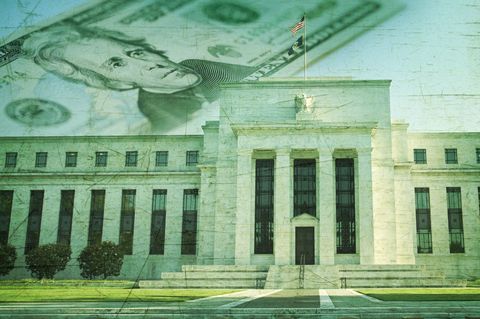European markets had a disappointing day yesterday, after a series of disappointing earnings reports, as well as further economic data that appeared to suggest the region is sliding towards a slowdown, and a deflationary funk with a host of weak German inflation numbers, while the French economy showed a weaker than expected expansion in Q2 of 0.2%.
Today’s flash EU CPI numbers for July could reinforce this even further, if as expected they weaken further, with both headline and core measures expected to fall back further to 1%. The latest flash GDP readings for Q2 are also likely to be sobering, with an expectation that we could slip back from 0.4% in Q1 to 0.2%.
US markets also fell back after President Trump had another pop at China over Twitter on trade, accusing them of being unreliable, prompting a paring back of positions ahead of today’s Fed meeting.
There’s been a lot of speculation over the past few weeks over whether we’ll get to see the US Federal Reserve cut rates by 25bps or 50bps when they conclude their July meeting later today, when the real discussion ought to be about whether they should be even cutting rates at all.
For years now we’ve heard the Federal Reserve insist that they would be driven by the data, and for the most part they have been true to that narrative in the aftermath of the financial crisis over ten years ago.
This narrative appears to have undergone a marked shift in the past few months, and in some respects it’s not hard to see why, with political pressure to cut rates at abnormally high levels, and a global economy that is struggling to maintain momentum.
At the end of last year, the real concern was that the Fed was tightening too quickly, in the face of growing storm clouds, however the central bank quickly realised that to do such a thing might well be a mistake.
Now it appears that the Fed is about to embark on a rate cut, which too all intents and purposes looks like an attempt to mollify a US President who has his own agenda, and who thinks the central bank is a tool for his own political ends.
Quite simply the current data in no way warrants a rate cut, whether it be 25bp or 50bp, with trend growth much higher than when the Fed started its hiking cycle and unemployment which is still near multi year lows.
On Friday the US economy managed to expand at 2.1% in Q2, while US consumer confidence in July rose to its best level this year in numbers released yesterday. This ought to augur well for Friday’s July payrolls report, while wages are still increasing above 3%, nearly twice the rate of core inflation.
Putting all of that to one side, the fact is that markets have convinced themselves that we will see, at the very least, a 25bps cut in the Fed funds rate later today. A 50bp cut, which some on the margins are calling for, is highly unlikely, given the strength of recent data.
In any case any easing of the Fed Funds rate will come at a time when the Fed is still reducing the size of its balance sheet by $50bn a month, which means in essence, the Fed will be easing with one hand and tightening with the other.
A large part of this belief in a rate cut has come from the fact that in recent testimony Fed chairman Jay Powell referenced the effects of cross currents in global trade, and a slowdown in business investment, which might start to ripple through the US economy. He also referenced a weak inflationary outlook, which has added to that overall belief.
While all of these are legitimate concerns, there doesn’t appear much evidence that the US economy is feeling the effects quite yet, which means, based on the data, some US policymakers could well take some convincing of the need for a cut in rates, which means we could well see up to two to three dissents on any decision to ease policy.
Recent comments from the likes of Esther George of the Kansas City Fed and Eric Rosengren of the Boston Fed would suggest that they don’t favour a move lower in the headline rate, but might concede to a 25bp cut, for the sake of unanimity, if they felt it was being presented as a one and done type of move.
Against such a backdrop it will be interesting to see how chair Jay Powell spins the narrative that they are data dependent at a time when the only weakness in the economy appears to be in a sector that is a fairly small part of the US economy. How this message is crafted is likely to dictate how bond markets react, given that they are well priced for more than one rate cut this year.
The data seen thus far in no way supports the pricing for multiple rate cuts which means a one and done cut could result in a sharp repricing of risk, not to mention upsetting President Trump, however that is a small price to pay for maintaining the central banks credibility.
The pound continued its recent role as the whipping boy of the currency markets yesterday after Prime Minister Johnson made it clear he had no intention of meeting EU leaders unless they were willing to compromise on removing the Irish backstop.
EURUSD – continues to hold above its recent lows just above 1.1100 but the rallies remain weak. The bias remains for a move lower towards the 1.1000 area, while below 1.1280. We need to see a recovery back above 1.1280 to retarget the 1.1400 area.
GBPUSD – has continued to slide lower with the next key support area down near the 1.2100 area, with a break targeting the 2017 lows at 1.1985. Needs to hold push back above the 1.2580 area to stabilise and retest the 1.2700 area.
EURGBP – pushed through the highs last month at 0.9050 and through the highs this year, and could well retest the highs of 2016 and 2017 up around the 0.9300 area. This is likely to be a key level, which if broken could see further gains towards the 2009 peaks at 0.9805.
USDJPY – needs to push up through the 108.80 area to signal a retest of the 109.20/30 area. Bias remains to the downside and the 106.00 area, while below the 109.20 area.
Disclaimer: CMC Markets is an execution-only service provider. The material (whether or not it states any opinions) is for general information purposes only, and does not take into account your personal circumstances or objectives. Nothing in this material is (or should be considered to be) financial, investment or other advice on which reliance should be placed. No opinion given in the material constitutes a recommendation by CMC Markets or the author that any particular investment, security, transaction or investment strategy is suitable for any specific person. The material has not been prepared in accordance with legal requirements designed to promote the independence of investment research. Although we are not specifically prevented from dealing before providing this material, we do not seek to take advantage of the material prior to its dissemination.






